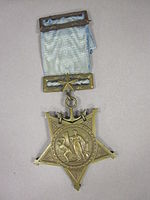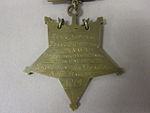| Frank Friday Fletcher | |
|---|---|
 Admiral Frank F. Fletcher wearing his Medal of Honor, c. 1919 | |
| Born | November 23, 1855 |
| Died | November 28, 1928 (aged 73) |
| Place of birth | Oskaloosa, Iowa |
| Place of death | New York City |
| Place of burial | Arlington National Cemetery |
| Allegiance |
|
| Service/branch |
|
| Years of service | 1875–1919 |
| Rank |
|
| Commands held | Atlantic Fleet |
| Battles/wars |
Battle of Veracruz World War I |
| Awards |
Medal of Honor Navy Distinguished Service Medal |
| Relations | Frank Jack Fletcher (nephew) |
Frank Friday Fletcher (November 23, 1855 – November 28, 1928) was an United States Navy admiral who served in the late 19th and early 20th centuries. He was awarded the U.S. military's highest decoration, the Medal of Honor, for his actions as commander of Navy forces at the Battle of Veracruz, Mexico. He was the uncle of Frank Jack Fletcher, also a U.S. Navy Admiral.
Biography[]
Fletcher was born on November 23, 1855, in Oskaloosa, Iowa. He was the uncle of World War II Admiral Frank Jack Fletcher. He graduated from the U.S. Naval Academy in 1875 and spent the next year as a midshipman on USS Tuscarora. Promoted to ensign in July 1876, he had sea duty on the sloops of war Portsmouth, Plymouth, Lackawanna and Constellation before participating in USS Ticonderoga's voyage around the world in 1878–1881. Fletcher advanced to the rank of master (later lieutenant, junior grade) in April 1882 and was next assigned to the Hydrographic Office in Washington, D.C. In July 1884, he reported to USS Quinnebaug for service in European waters. After ordnance training in late 1887, he had five years' duty at the Bureau of Ordnance, during which time he was promoted to lieutenant and made notable contributions to gun mechanism design and shipboard navigation.[1]
From 1892 to 1895, Fletcher commanded USS Cushing (TB-1), based at the Torpedo Station in Newport, Rhode Island, and developed the Navy's first torpedo warfare doctrine. He then served in the battleship USS Maine (ACR-1) before returning to the Newport Torpedo Station in October 1896. After a brief tour as Assistant Chief of the Bureau of Ordnance in the spring of 1898, Lieutenant Fletcher became commanding officer of the converted yacht USS Kanawha. From October 1898 to July 1901 he commanded the surveying ship USS Eagle and, in March 1899, was promoted to lieutenant commander.[1]
In the fall of 1901, Fletcher returned to ordnance duty and was closely involved with torpedo warfare. A year later he became Chief of Staff of the Asiatic Fleet and later in 1905 assumed command of the cruiser USS Raleigh (C-8). Fletcher attended the Naval War College courses in both 1907 and 1908 and in 1908 was assigned to the Navy's General Board during the next year. He was promoted to captain in May 1908 and from November of that year to March 1910 he commanded the battleship USS Vermont (BB-20). In the spring of 1910, Fletcher became the Secretary of the Navy's Aid for Material. While in that post, he reached the rank of rear admiral. From 1912 to 1914, he commanded battleship divisions of the Atlantic Fleet. In April 1914, Fletcher led U.S. Navy forces during the landings at Vera Cruz, Mexico, receiving the Medal of Honor for his "distinguished conduct in battle".[1]
In September 1914, Fletcher began two years as the Atlantic Fleet's Commander in Chief, and was elevated to the rank of admiral in March 1915, the senior of the first three officers to hold the new four-star positions.[2] He was a member of the General Board, the Joint Army and Navy Board and the War Industries Board in 1916–1919, and was awarded the Navy Distinguished Service Medal for "meritorious service" during World War I. Retired on November 23, 1919, with the rank of rear admiral (as was customary at that time), he subsequently served as an official advisor on contemporary defense issues. Fletcher died on November 28, 1928, in New York City.[3] He was buried in Arlington National Cemetery.[1]
Legacy[]
The Fletcher-class destroyer (named after Admiral Frank F. Fletcher) was the largest class of destroyer produced during WW2, with 175 completed. The lead ship in the class USS Fletcher (DD-445), was in commission from 1942 to 1969.
Medal of Honor citation[]
Rank and organization: Rear Admiral, U.S. Navy. Born: November 23, 1855, Oskaloosa, Iowa. Accredited to: Iowa. G.O. No.: 177, December 4, 1915.
Citation:
For distinguished conduct in battle, engagements of Vera Cruz, 21 and 22 April 1914. Under fire, Rear Adm. Fletcher was eminent and conspicuous in the performance of his duties; was senior officer present at Vera Cruz, and the landing and the operations of the landing force were carried out under his orders and directions. In connection with these operations, he was at times on shore and under fire.
Dates of rank[]
- Midshipman: June 18, 1870
- Passed Midshipman: June 21, 1875
- Master: April 8, 1882
| Ensign | Lieutenant Junior Grade | Lieutenant | Lieutenant Commander | Commander | Captain |
|---|---|---|---|---|---|
| O-1 | O-2 | O-3 | O-4 | O-5 | O-6 |

|

|

|

|

|

|
| July 18, 1876 | March 3, 1883 | February 18, 1889 | March 3, 1899 | Unknown | May 1908 |
| Commodore | Rear Admiral | Vice Admiral | Admiral |
|---|---|---|---|
| O-7 | O-8 | O-9 | O-10 |

|

|

|

|
| Unknown | October 1911 | Unknown | March 10, 1915 |
See also[]
| Wikimedia Commons has media related to Frank Friday Fletcher. |
References[]
- This article incorporates text from the public domain Dictionary of American Naval Fighting Ships.
- ↑ 1.0 1.1 1.2 1.3 "Admiral Frank F. Fletcher, USN, (1855-1928)". Online Library of Selected Images. Naval History & Heritage Command. June 16, 2006. http://www.history.navy.mil/photos/pers-us/uspers-f/ff-fltr.htm. Retrieved March 17, 2011.
- ↑ "3 New Admirals Named By President. Fletcher Is Senior, Howard Next, and Cowles Junior in Order of Precedence. Will Hold New Rank While in Command. Vice Admirals to be Appointed Later". March 11, 1915. http://select.nytimes.com/gst/abstract.html?res=F30917FB3E5D16738DDDA80994DB405B858DF1D3. Retrieved 2011-03-18. "President Wilson today designated the three new Admirals of the American Navy provided for by the Naval Appropriation bill. They are Frank Friday Fletcher, Commander in Chief of the Atlantic Battleship Fleet, now in Cuban waters; Thomas B. Howard, Commander in Chief of the Pacific Fleet, now at San Diego, Cal., and Walter C. Cowles, Commander in Chief of the Asiatic Fleet, now at Olongapo, Philippines. ..."
- ↑ "Admiral Fletcher Dies At Age Of 73. Former Commander-in-Chief of Atlantic Fleet Succumbs After an Operation. To Be Buried In Arlington. Was in Command at Capture of Vera Cruz 14 Years Ago. An Inventor of Note". November 29, 1928. http://select.nytimes.com/gst/abstract.html?res=F70714FB3E5A127A93CBAB178AD95F4C8285F9. Retrieved 2011-03-18. "Rear Admiral Frank Friday, Fletcher, U.S.N., retired, who held the rank of admiral while commander-in-chief of the Atlantic fleet and..."
- Lewis Randolph Hamersly (1889). Dates of promotion from (Sixth Edition ed.). http://books.google.com/books?vid=0waiEcVzn9_RgiLXel&id=REQUIE_aDoIC&printsec=titlepage#PRA7-PA185,M1. Retrieved October 5, 2010.
The original article can be found at Frank Friday Fletcher and the edit history here.

